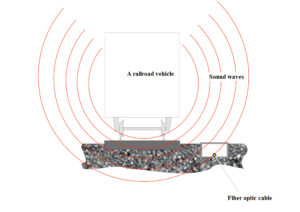 Distributed fiber optic sensing is considered to be an advanced technology that allows changing the principle of infrastructure management. The fiber optic technology converts optical fibers into thousands of sensors and controls tens of kilometers of an asset with a single FBG interrogator. Thus, optical fiber sensors are a highly cost-effective fiber optic solution that is used by numerous industries every year.
Distributed fiber optic sensing is considered to be an advanced technology that allows changing the principle of infrastructure management. The fiber optic technology converts optical fibers into thousands of sensors and controls tens of kilometers of an asset with a single FBG interrogator. Thus, optical fiber sensors are a highly cost-effective fiber optic solution that is used by numerous industries every year.
Herewith, Distributed Acoustic Sensing or DAS technology has a wider scope of potential fiber optic applications, both scientific (seismic, mechanical) and industrial (security, integrity, operation monitoring) because DAS detects vibrations along with the optical fiber. It should be noted that the detection and analysis of sound waves remains one of the most effective techniques for sensing information.
The principle of distributed acoustic sensing operation is based on the use of a fiber optic cord that is placed in an acoustic sensing housing that picks up sounds along the length of the cord. Therefore, DAS technology makes it possible to obtain a more detailed scan of hazardous or hard-to-reach places.
Moreover, the additional DAS benefit includes the possibility to identify the strain of the fiber optic cord to help prevent damages. The fields of DAS applications include the sensing disturbances around fracking operations underground that is possible to perform during and after the process to ensure safety. Also, distributed acoustic sensing can be applied to guide the fracking operation to the right underground deposits.
Generally, the DAS system is used to offer less disturbance to places applied for oil drilling and fracking. Nevertheless, DAS technology is ideally suited for the measurement of seismic events and control of fault lines with less of an equipment footprint and impact on the surrounding area.
Distributed acoustic sensing offers the following advantages that include:
- High precision due to its linear response;
- Very high sensitivity;
- Great coverage, exceeding 70 km;
- The possibility of programming real-time applications directly on the device.
Finally, the fields of DAS applications continue expanding. At the present time, it includes perimeter intrusion detection, third-party interference detection, power cable monitoring, traffic monitoring (roads, railway, subway), seismic activity monitoring, subsea cable monitoring, asset integrity, oil, gas, and water pipelines.
Optromix is a DAS system manufacturer that provides top of the line distributed acoustic sensing systems suitable for monitoring of commerce networks. If you have any questions or would like to buy a DAS system, please contact us at info@optromix.com

